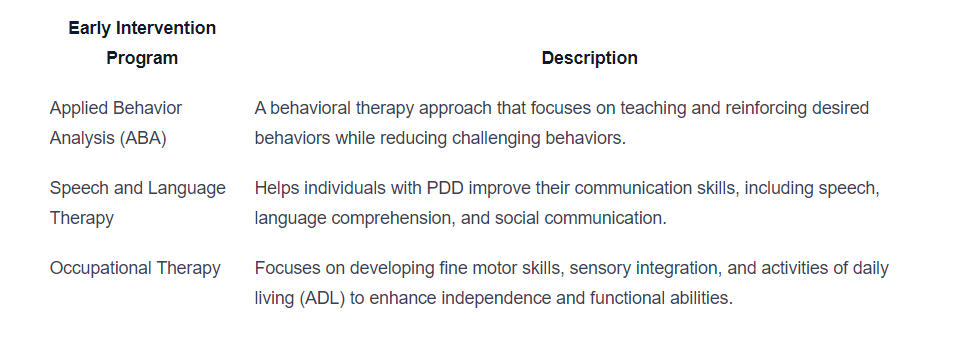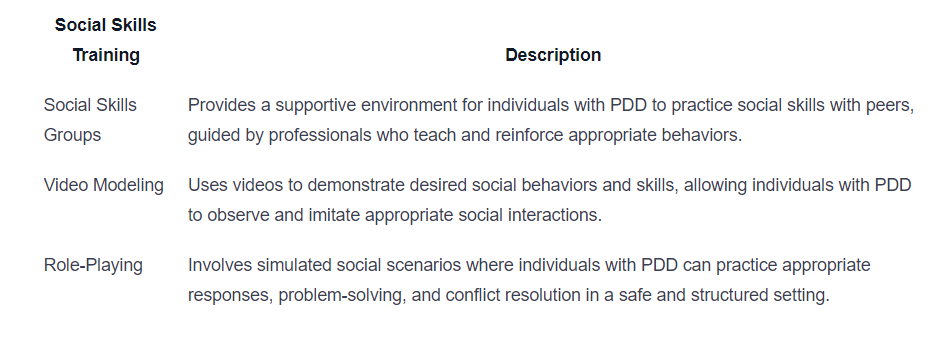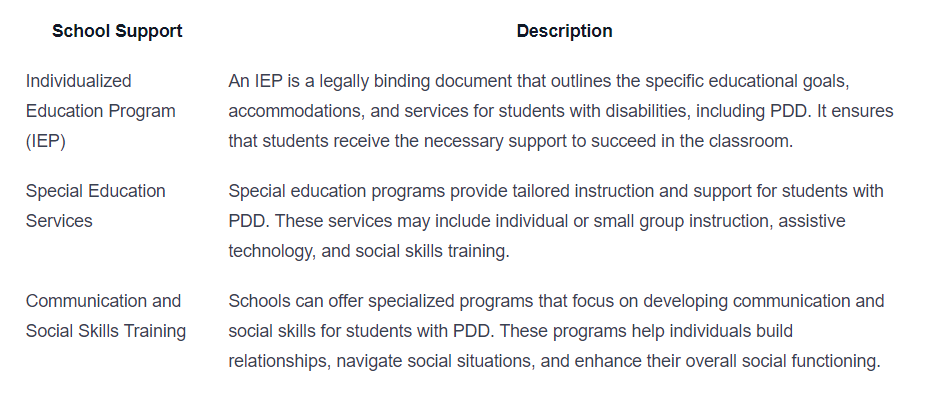Pervasive Developmental Disorder (PDD)
Empower those with pervasive developmental disorder (PDD) to thrive! Discover strategies and support for a fulfilling life.

Understanding Pervasive Developmental Disorder (PDD)
To gain a comprehensive understanding of Pervasive Developmental Disorder (PDD), it is essential to explore what it entails and the different types that fall under this category.
-80.jpeg)
What is Pervasive Developmental Disorder?
Pervasive Developmental Disorder (PDD) is an umbrella term used to describe a group of neurodevelopmental disorders characterized by difficulties in social interaction, communication, and repetitive patterns of behavior. Individuals with PDD often have challenges with social communication and exhibit restricted and repetitive behaviors or interests.
PDD is typically diagnosed in early childhood, and its symptoms can vary in severity from person to person. It is considered a lifelong condition, but with appropriate support and interventions, individuals with PDD can lead fulfilling lives.
Types of PDD
There are several specific disorders that fall under the umbrella of Pervasive Developmental Disorder. These include:

Understanding the different types of PDD is crucial in recognizing the unique challenges and strengths associated with each disorder. By gaining knowledge about PDD and its specific categories, individuals, families, and communities can better support and advocate for those with PDD.
Diagnosis and Treatment
When it comes to pervasive developmental disorder (PDD), an accurate diagnosis and appropriate treatment are essential for individuals to thrive. Let's delve into the process of diagnosing PDD and explore the different treatment options available.
Diagnosis of PDD
Diagnosing PDD involves a comprehensive evaluation by a healthcare professional, typically a developmental pediatrician, child psychologist, or psychiatrist. The diagnosis is based on careful observation, interviews with parents or caregivers, and the assessment of the individual's behavior and development.
To diagnose PDD, the healthcare professional considers the presence of specific symptoms and behaviors that align with the diagnostic criteria outlined in the Diagnostic and Statistical Manual of Mental Disorders (DSM-5). These symptoms may include difficulties with social interaction, communication deficits, repetitive behaviors, and restricted interests.
It's important to note that PDD encompasses a range of disorders, such as autism spectrum disorder (ASD), Asperger's syndrome, and childhood disintegrative disorder. The specific diagnosis within the PDD umbrella depends on the individual's unique symptoms and characteristics.
Treatment Options for PDD
The treatment for PDD is multifaceted and tailored to the individual's specific needs. It typically involves a combination of therapies and interventions aimed at improving communication, social skills, and overall functioning. The primary treatment options for PDD include:

In addition to these primary treatment options, other interventions may be incorporated based on the individual's specific needs. These may include speech and language therapy to improve communication, occupational therapy to enhance fine motor skills and sensory processing, and medication management to address associated conditions like anxiety or attention deficits.
It's important to remember that treatment plans should be individualized and regularly reassessed to ensure they align with the individual's progress and changing needs. Collaborating with a team of professionals, including therapists, educators, and healthcare providers, can help create a comprehensive and effective treatment approach for individuals with PDD.
Strategies for Thriving with PDD
Individuals with Pervasive Developmental Disorder (PDD) can benefit from various strategies to help them thrive and reach their full potential. In this section, we will explore three key strategies: early intervention programs, behavioral therapies, and social skills training.
Early Intervention Programs
Early intervention programs play a crucial role in supporting individuals with PDD. These programs provide targeted interventions and therapies during the early developmental stages, aiming to improve communication, social interaction, and adaptive skills.
These programs typically involve a multidisciplinary approach, with professionals such as speech-language pathologists, occupational therapists, and behavior analysts working together to create individualized treatment plans. The focus is on addressing specific areas of challenge and promoting overall development.

Behavioral Therapies
Behavioral therapies are highly effective in helping individuals with PDD manage challenging behaviors, develop coping mechanisms, and acquire new skills. These therapies utilize evidence-based techniques to address specific behavioral issues and promote positive outcomes.

Social Skills Training
Social skills training is essential for individuals with PDD to navigate social interactions successfully. These training programs focus on teaching and practicing social skills, such as initiating conversations, making eye contact, and understanding nonverbal cues.

These strategies, including early intervention programs, behavioral therapies, and social skills training, can significantly contribute to the well-being and overall development of individuals with PDD. It's important to remember that each person is unique, and a personalized approach that considers individual strengths and challenges is crucial for success.
Support Systems for Individuals with PDD
Navigating life with pervasive developmental disorder (PDD) can be made easier with the support of various systems. These support systems play a crucial role in providing assistance, guidance, and resources for individuals with PDD and their families. Let's explore three important support systems: family support, school support, and community resources.
Family Support
Family support is an essential component in the journey of individuals with PDD. Families can provide love, understanding, and acceptance, creating a nurturing environment for individuals with PDD to thrive. Here are some ways in which families can offer support:
- Emotional Support: Families can provide emotional support by being there for their loved ones with PDD, actively listening to their concerns, and validating their experiences.
- Education and Advocacy: Families can educate themselves about PDD, its challenges, and available resources. By becoming knowledgeable advocates, they can ensure that their loved ones receive the appropriate support and services.
- Structured Environment: Establishing routines and providing a structured environment at home can help individuals with PDD feel secure and enhance their overall well-being.
- Collaboration with Professionals: Families can collaborate with healthcare professionals, therapists, and educators to develop personalized strategies and interventions that address the unique needs of their loved ones.
School Support
Schools play a crucial role in supporting individuals with PDD as they navigate their education. Students with PDD may require additional support and accommodations to succeed academically and socially. Here are some forms of school support:

Community Resources
Community resources can provide additional support and opportunities for individuals with PDD and their families. These resources can offer a range of services, including therapy, recreational activities, and support groups. Here are some examples of community resources:
- Therapeutic Services: Community-based therapy centers often provide specialized therapies, such as occupational therapy, speech therapy, and applied behavior analysis (ABA) therapy, which can help individuals with PDD develop essential skills and overcome challenges.
- Recreational Programs: Community recreation centers may offer inclusive recreational programs that allow individuals with PDD to participate in various activities alongside their peers, promoting socialization and skill development.
- Support Groups: Support groups can provide a sense of community and understanding for individuals with PDD and their families. These groups offer a platform for sharing experiences, exchanging information, and gaining emotional support from others who are facing similar challenges.
By harnessing the support of family, school, and community resources, individuals with PDD can receive the assistance they need to lead fulfilling lives. These support systems foster inclusion, enhance overall well-being, and empower individuals with PDD to reach their full potential.
Building Independence and Self-Advocacy
Individuals with Pervasive Developmental Disorder (PDD) can lead fulfilling lives by focusing on building independence and developing self-advocacy skills. This section explores strategies to encourage independence and teach self-advocacy, empowering individuals with PDD to navigate their world with confidence.
Encouraging Independence
Encouraging independence is key to fostering self-reliance and personal growth in individuals with PDD. By providing opportunities for independent decision-making and skill development, we can support them in becoming more self-sufficient. Here are some strategies to promote independence:
- Task-based Approach: Breaking tasks into smaller, manageable steps can help individuals with PDD feel more confident in accomplishing them independently. Provide clear instructions and visual aids to facilitate understanding.
- Gradual Progression: Start with simpler tasks and gradually introduce more complex ones. This allows individuals to build their skills progressively, boosting their self-esteem and motivation.
- Positive Reinforcement: Recognize and praise their efforts, focusing on their achievements rather than their challenges. Positive reinforcement can motivate individuals with PDD to continue striving for independence.
- Promote Problem-Solving: Encourage individuals to find solutions to everyday challenges. Teach them problem-solving techniques, such as brainstorming, evaluating options, and making informed decisions.
Teaching Self-Advocacy Skills
Self-advocacy empowers individuals with PDD to express their needs, desires, and rights effectively. By developing self-advocacy skills, they can navigate social situations, make informed decisions, and advocate for themselves. Here are some strategies to teach self-advocacy skills:
- Communication Skills: Help individuals with PDD improve their communication skills, such as clear speech, active listening, and understanding non-verbal cues. Role-playing and social stories can be effective tools for practicing social interactions.
- Self-Awareness: Encourage individuals to develop self-awareness by understanding their strengths, limitations, and emotions. This enables them to communicate their needs and preferences more effectively.
- Self-Expression: Teach individuals with PDD how to express their thoughts, feelings, and opinions assertively and respectfully. Providing opportunities for self-expression through art, writing, or discussions can boost their confidence.
- Advocacy Training: Offer guidance on understanding rights and advocating for accommodations and support. This can include teaching them about disability laws, accessing resources, and working collaboratively with teachers, employers, or healthcare professionals.
By focusing on building independence and developing self-advocacy skills, individuals with PDD can enhance their quality of life and thrive in various aspects. Encouraging independence and teaching self-advocacy empower them to navigate challenges, make informed decisions, and actively participate in society.
Embracing Neurodiversity
Individuals with pervasive developmental disorder (PDD) have unique strengths and challenges that contribute to the concept of neurodiversity. Embracing neurodiversity means recognizing and valuing the diversity of human brains and abilities. In the context of PDD, embracing neurodiversity involves celebrating differences and promoting inclusion.
Celebrating Differences
One of the fundamental aspects of embracing neurodiversity is celebrating the differences that individuals with PDD bring to society. Each person with PDD has their own set of strengths, talents, and perspectives that can enrich our communities. By acknowledging and appreciating these differences, we create an environment that fosters acceptance and understanding.
It is important to educate others about PDD and dispel misconceptions or stereotypes. Highlighting the unique qualities and abilities of individuals with PDD can help promote a more inclusive society. By celebrating the diverse talents and contributions of individuals with PDD, we can create a culture that values and respects their perspectives.
Promoting Inclusion
Promoting inclusion is another crucial aspect of embracing neurodiversity. Inclusion means ensuring that individuals with PDD are fully integrated into various aspects of society, including education, employment, and social interactions. By providing equal opportunities and support, we can empower individuals with PDD to participate and contribute meaningfully.
Schools play a vital role in promoting inclusion for individuals with PDD. Implementing inclusive education practices, such as providing individualized support and accommodations, can help students with PDD thrive academically and socially. It is important to foster a supportive and inclusive environment where all students feel valued and accepted.
In the workplace, promoting inclusion involves creating an environment that is accommodating and supportive of individuals with PDD. This can include providing reasonable workplace adjustments, such as modified work schedules or task assignments, to ensure equal opportunities for success. Employers can also offer training and awareness programs to educate colleagues about PDD and promote a culture of acceptance and understanding.
In the wider community, promoting inclusion means creating opportunities for individuals with PDD to participate in social, recreational, and cultural activities. This can be achieved through community programs, support groups, and inclusive events that cater to the diverse needs and interests of individuals with PDD.
By embracing neurodiversity and promoting inclusion, we can foster a society that values and supports individuals with PDD. Celebrating differences and promoting inclusion not only benefits individuals with PDD but also enriches our communities by embracing the unique perspectives and contributions they bring.
Sources
https://www.ninds.nih.gov/health-information/disorders/pervasive-developmental-disorders
https://www.webmd.com/brain/autism/development-disorder
https://my.clevelandclinic.org/health/diseases/pervasive-developmental-disorders
Similar articles
We’re here to help you

Our team is here to assist you in this process. Contact us for any assistance.
it’s easy to apply
We Accept Most Insurances
Our in-network insurance partnerships make ABA therapy more accessible to families throughout our service areas.







Our Insurance Process
We'll request your insurance details to help us verify your plan's coverage for ABA therapy. Once we've received this information, we'll walk you through your benefits, including copayments, deductibles and out-of-pocket maximums, so you know what to expect in advance.
Our team will then handle the preauthorization and all the necessary paperwork.
.svg)





















.jpeg)


































.jpeg)




.jpeg)







.jpeg)











.jpeg)
















